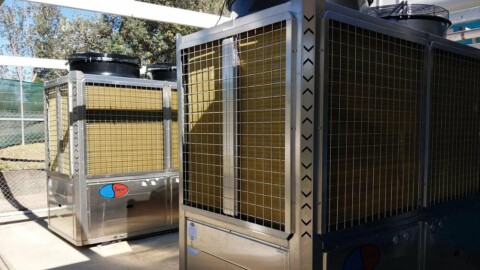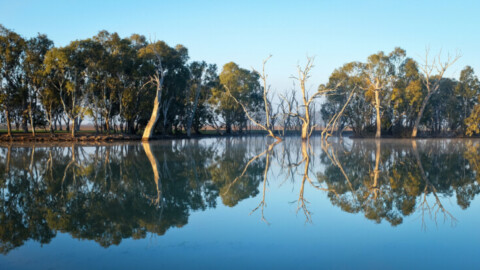Situated roughly 500km south-east of Darwin is the Beetaloo Sub-basin, an enormous shale gas reserve known for its vast energy potential and significant natural resources. Here we take a look at fracking in the Beetaloo and explore how pumps are used in this controversial process.
The role of gas in Australia’s energy transition continues to be the subject of ongoing debate. As the nation gradually increases its renewable capacity, many argue that new gas projects play a vital role in the energy mix.
However, this line of argument has also been called into question, as Australia exports a significant amount of the gas it produces. Gas projects involving hydraulic fracturing (fracking), the method of extracting gas from shale formations, face even more controversy.
In the Northern Territory, many have raised concerns about the impacts of fracking in the Beetaloo Sub-basin – a significant natural gas reserve. The Territory Government, however, has cited its potential to help meet energy demands and boost the region’s jobs and economic growth.
In May 2023, the Northern Territory Government gave Beetaloo the green light to move into commercial production. Three companies –Tamboran Resources, Empire Energy and Santos – are currently exploring in the Beetaloo. As the holder of the biggest tenement position across the site, Empire Energy welcomed the announcement.
Empire Energy Managing Director, Alex Underwood, said, “Building on the encouraging results of our exploration activity over the last four years, we look forward to submitting applications for all required approvals to enable us to move into gas production and the delivery of much-needed new gas supply to the Australian domestic market, and subsequently to increase LNG exports, already the NT’s largest source of foreign income and a significant contributor to Federal Government revenues.”
Empire Energy has conducted extensive seismic surveys and exploratory drilling programs in the Beetaloo. The company has been evaluating the potential gas resources in the basin, assessing gas content and productivity to determine the viability of gas extraction.
In late 2021, Empire announced it had successfully drilled, cased, and suspended Carpentaria-2H (C-2H) – its first horizontal well located within its 100 per cent owned and operated EP187 tenement. Fracking activities in C-2H began in July 2022.
The role of pumps in fracking
There are two primary pumping and pressure applications involved in the upstream production process. The first application is the extraction of water and gas from the wells, while the second is the compression of the gas for transport via high-pressure pipelines.
Fracking involves injecting a fluid mixture into the wellbore to create fractures in the shale rock. Various types of pumps are used to generate the high pressure needed to push fracking fluid into the well, causing the rock to fracture and create pathways for the trapped gas or oil to flow. Pumps must be large and robust to be able to handle the demanding conditions of the process.
Progressive cavity pumping systems are often used to extract water from the wells. These systems utilise progressive cavity pumps, which are lowered into the well casing on steel tubing to a depth of around 800 to 1000 metres.
The pumps are driven by a rotating steel shaft connected to the surface, either through a hydraulic power unit driven by a gas-fired engine or electrically using a gas-fired microturbine combined with a variable frequency drive.
As the progressive cavity pump rotor spins, water is forced up inside the steel tubing. This extraction of water helps reduce pressure in the targeted shale formations, enabling the release of natural gas. The gas flows to the surface between the well casing and tubing due to the lowering of water levels and pressure.
Triplex or quintuplex pumps, a different type of positive displacement pump, are frequently used in fracking. These pumps are capable of generating the high pressures required for fracking activities. Centrifugal pumps are often used in fracking for specific purposes, such as transferring or circulating fluids within the fracking system.
They operate by using an impeller to create centrifugal force that pushes the fluid outward, generating pressure and flow. Centrifugal pumps are typically employed for water transfer, fluid circulation, or blending operations during the fracking process.
Following extraction, at the wellhead, the extracted gas and water are separated and sent through separate low-pressure gathering pipeline systems. The gas is then compressed to sales gas pressure for transportation via high-pressure pipelines. The water is directed to central water treatment facilities for further processing and treatment.
Pumps used in fracking are also closely monitored and controlled to maintain the desired pressure, flow rate, and fluid consistency.
Advanced technologies and sensors are often employed to monitor pump performance, ensuring efficient and effective operations. Frack programs are often designed to meet the unique geological and reservoir conditions of the region.
Empire has tested a number of frack fluid mixes to understand which design will achieve the best production results. One challenge with fracking is that materials pumped underground need to be slowly removed over a matter of weeks, in order to keep the perforations steady and stabilise pressure downhole.
Fracking waste materials are transported to a dump on-site or into tanks, depending on cost and logistics. Once fracking materials (including sand abrasive liquids, acids and expanding gels) have been removed, companies are able to commence gas flow testing.

Advancing operations in the Beetaloo
Empire Energy’s C-2H well production test provided the company with an early production-type curve and a better understanding of gas composition in developing a full field development plan, including processing and gas handling facilities.
In May 2023, the company announced it had wound up its latest round of flowtesting at C-2H, pulling up a total of 323 terajoules over 127 days. As well as monitoring the well’s flow rates, the company also used pump tests to garner important information, examining the benefits of soaking in Beetaloo and understanding the flow characteristics of the Velkerri B shale host.
Soaking refers to when injected fracturing fluid is left to sit in the wellbore and the formation for a certain period of time. During soaking, the fluid interacts with the rock formation, allowing it to penetrate deeper and initiate or enhance the creation of fractures. Pumps are usually shut off during this stage.
Following the completion of flow testing, Empire Energy shut-in C-2H and earmarked the well as a future gas producer. In early March 2023, the company announced it had put its Carpentaria-H3 (C-3H) well through its paces by testing flow pressure for 27 days straight. It then began the shut-in processes for soaking after fracture simulation. This refers to a series of complex processes to increase the flow pressure of the well.
In late March, Empire announced it had lifted its average 30-day gas flow rate by more than 17 per cent in initial tests held at the Beetaloo Basin, citing the results as validation of its soaking strategy. The company recently released revised estimates of its EP187 resource, which includes technical results from its 2022 drilling, fracture stimulation and production-testing campaign.
Empire’s management believes that results from its C-2H and C-3H wells demonstrate that it can cost-effectively deliver 3km of hydraulically-stimulated horizontal wells utilising Australia’s existing rig and frack spread fleet. The wells represent the intended design for future development of its Carpentaria project at EP187.
Concerns surrounding fracking
While government support has allowed Empire Energy to increase its portfolio of gas opportunities and move projects in Beetaloo forward, controversy still surrounds the development.
The risks associated with fracking include:
- Air pollution: fracking involves the release of volatile organic compounds and hazardous air pollutants, which can have detrimental effects on human health and contribute to climate change
- Risk to water resources: fracking requires large amounts of water mixed with chemicals that may be harmful and can potentially contaminate groundwater through leaks or improper disposal of wastewater
- Induced seismicity: fracking has triggered small to moderate earthquakes in some regions
- Greenhouse gas emissions: the extraction and burning of fossil fuels obtained through fracking contributes to emissions, exacerbating climate change

Fracking can also have social and economic impacts, such as increased truck traffic, noise pollution, disruptions to local communities and conflicts over land and finite water resources.
The Federal Government has played a major role in supporting the exploration and development of the Beetaloo, with the previous coalition government committing significant amounts of funding. This support has drawn condemnation from some communities, including traditional owners who fiercely oppose the development.
Empire Energy was awarded $21 million from the Federal Government under the Beetaloo Cooperative Drilling Program, sparking a federal court challenge by environmental activists, who argued that the decision to give Empire the money was unlawful because the federal resources minister at the time failed to properly consider the risks to global heating.
However, in October 2021 the company announced it had secured environmental approval from the Northern Territory Government, granting it permission to drill new wells in the basin.
Concerns around fracking led to an almost two-year moratorium on unconventional sale gas developments in the Territory, beginning in 2016. An independent Scientific Inquiry into Hydraulic Fracturing of Onshore Unconventional Reservoirs in the Northern Territory was also initiated.
Findings were handed down to the Territory Government in 2018. It announced it had accepted all of the recommendations and lifted the moratorium. One of the key recommendations was the Strategic Regional Environmental and Baseline Assessment (SREBA), which the government committed to finalising before any production licences were issued.
The three-year SREBA study found no new risks associated with the development of an onshore gas industry and in 2023 the Territory Government announced it had finalised all 135 recommendations of the inquiry, including a new regulatory framework for fracking. This set the stage for approval of gas production in the Beetaloo.
The Territory’s independent regulator has disputed the claim that the government met all of the recommendations of the inquiry before approving fracking. Regardless of the Northern Territory Government’s decision, the harmful effects of fracking and fossil fuels remain an issue. Empire is likely to begin construction on its Beetaloo pilot gas production facilities in early 2024.














